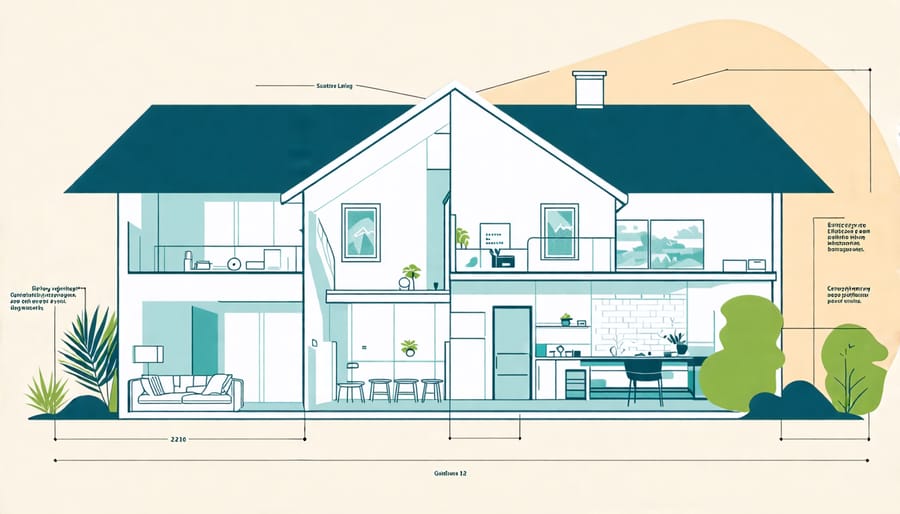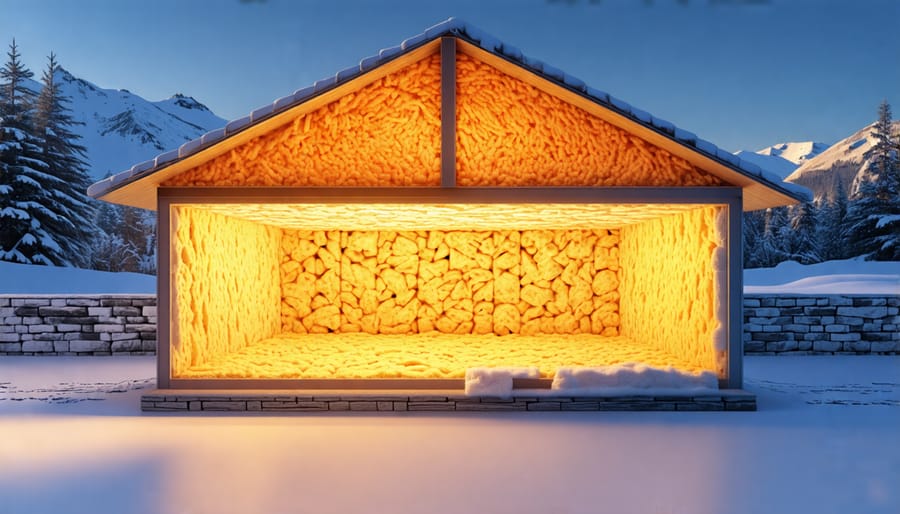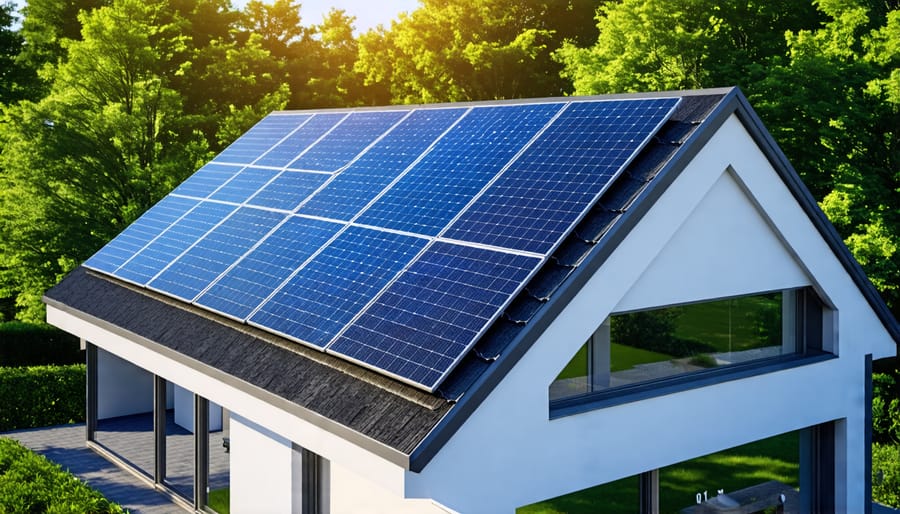Optimize your home’s efficiency by implementing these essential steps: Begin by insulating walls, roofs, and floors to minimize heat loss and ensure a comfortable indoor climate. Upgrade to double-glazed windows to enhance thermal insulation and reduce energy consumption. Install energy-efficient appliances, such as LEDs and ENERGY STAR-rated devices, to drastically cut down on electricity usage. Incorporate renewable energy sources by adding solar panels to your roof, reducing reliance on non-renewable energy and lowering utility bills. Embrace sustainable living by using eco-friendly materials during construction and furnishing. Each of these steps offers a clear path to a more energy-efficient home, aligning with modern sustainable practices while ensuring comfort and savings.
Understanding Energy Efficiency
What is Energy Efficiency?
Energy efficiency in home living is all about using less energy to achieve the same level of comfort and functionality. This involves making smart choices and employing strategies that reduce waste without sacrificing the coziness of your haven. By investing in energy-efficient appliances, insulating your home, and even incorporating eco-friendly cleaning practices, you not only help lower your energy bills but also contribute to a healthier environment. Ultimately, an energy-efficient home reflects thoughtful planning and design, ensuring your home is both economically and environmentally sustainable.
Benefits of an Energy-Efficient Home
Living in an energy-efficient home offers a host of benefits that go beyond just saving on utility bills—though that’s a big plus! Financially, these homes reduce energy consumption, translating into lower electricity and heating costs, leaving more money in your pocket. Environmentally, using less energy means a smaller carbon footprint, contributing to a healthier planet. On a lifestyle level, energy-efficient homes often provide improved comfort, with better insulation keeping you cozy in winter and cool in summer. You’ll also enjoy enhancements like superior air quality and reduced noise pollution, creating a more serene and inviting living space.
Step 1: Designing with Energy Efficiency in Mind
Optimal Orientation and Layout
Positioning your home to effectively utilize natural resources is key to energy efficiency. Start by orienting your home to take full advantage of the sun. In cooler climates, aim for a layout where the longest walls face south to maximize solar gain, soaking up warmth in the winter. In hotter regions, reduce exposure by using overhangs, awnings, or strategically placed trees to provide shade and keep indoor temperatures comfortable.
Plan your interior with functional living spaces on the sunniest side of the house; this can be your kitchen, dining area, or family room. Northern aspects are ideal for spaces that need less heating, like garages or storage, minimizing energy use.
Consider wind patterns, too. By placing windows and vents thoughtfully, you can create natural ventilation, reducing reliance on air conditioning. This combination of thoughtful layout and orientation not only cuts energy bills but also increases comfort, making your home a cozy, sustainable haven.

Choosing Sustainable Materials
When building an energy-efficient home, choosing sustainable materials is a pivotal step that marries both efficiency and longevity. Start with insulation—materials like cellulose, made from recycled paper, or sheep’s wool, offer excellent thermal properties and reduce heating and cooling demands. For walls and floors, consider bamboo or reclaimed wood. Not only do these options come from renewable sources, but they also add natural beauty and warmth to your home.
For windows, opt for double or triple glazing with wooden or composite frames to minimize heat loss. Such upgrades significantly improve energy retention while adding to the home’s aesthetic appeal. In terms of roofing, metal roofs are praised for their durability and ability to reflect solar heat.
Don’t forget about paint and finishes. Low-VOC products ensure healthier indoor air quality and offer a range of colors and finishes. By incorporating these sustainable materials, you’ll create a home that’s not only energy-efficient but also environmentally responsible and uniquely yours.
Step 2: Insulation and Ventilation
Effective Insulation Techniques
When it comes to building an energy-efficient home, effective insulation is crucial. Start by considering materials like fiberglass, cellulose, and spray foam. Each has its strengths: fiberglass is affordable and easy to install, cellulose is excellent for eco-conscious builders, and spray foam offers superior air sealing. For DIY enthusiasts, adding insulation to your attic is a great project. Expert tip: seal any gaps or cracks with caulk or weatherstripping before insulating to prevent air leaks. Don’t forget your walls and floors, too—insulating these areas will further boost your home’s energy efficiency. Pay special attention to the R-value, which measures thermal resistance, ensuring you select the right insulation for your climate. Investing time and effort into quality insulation will keep your home cozy and your energy bills low.

Ensuring Proper Ventilation
Creating a balanced ventilation system is key to maintaining both good air quality and energy efficiency in your home. To achieve this, consider installing a heat recovery ventilation system (HRV). This system expertly exchanges stale indoor air with fresh outdoor air while retaining warmth, cutting down energy use in the process. An HRV is perfect for climates with a significant temperature difference between indoors and outdoors. For milder climates, a simple exhaust-only system can be a cost-effective choice.
Incorporating operable windows in strategic locations also allows for natural ventilation, which can be both energy-saving and invigorating. Aim to place these windows where they can capture cross breezes, reducing the need for artificial cooling. Together, these strategies can transform your living space into an energy-efficient haven, enhancing comfort and sustainability. Remember, maintaining an optimal balance is essential for a healthier, greener home.
Step 3: Energy-Efficient Systems and Appliances
Heating, Cooling, and Water Systems
When building an energy-efficient home, choosing the right HVAC and water systems is crucial. Start by selecting an HVAC system with a high Seasonal Energy Efficiency Ratio (SEER) or Energy Efficiency Ratio (EER). These ratings indicate how efficiently a system operates in various conditions, helping you reduce energy consumption. For more detailed advice, check out these HVAC system tips. Next, consider a smart thermostat. It learns your habits, optimizing heating and cooling according to your schedule, which can lead to significant energy savings over time.
For water heating, tankless water heaters are an excellent option. They heat water on demand, eliminating the wasted energy associated with maintaining a tank of hot water. Solar water heaters also offer an eco-friendly choice, using the sun’s energy to preheat water, thereby reducing energy used by conventional heaters. By making informed decisions about these systems, you’ll take significant steps towards creating an energy-efficient home that’s comfortable and sustainable.
Choosing the Right Appliances
Choosing the right appliances for your home is a key step in building an energy-efficient haven. Start by looking for the ENERGY STAR label, a trusted symbol for energy-efficient products that will cut down on your electricity bills without sacrificing performance. It’s like shopping for a sneaky superhero that fights energy waste!
Prioritize essential household items like refrigerators, washing machines, and dishwashers. These large appliances account for a significant portion of your home’s energy use, so selecting efficient models can lead to substantial savings. Consider the size and capacity that best matches your family’s needs to avoid bigger appliances that consume more power than necessary.
Don’t forget smaller appliances like microwaves, toasters, and air purifiers. While they might seem insignificant, opting for energy-efficient versions can add up to noticeable savings over time. As a DIY enthusiast, you can also conduct a home energy audit to identify where improvements can be made, ensuring you’re always in control of your home’s energy consumption.
Step 4: Incorporating Renewable Energy Sources
Solar Panels
Installing solar panels is an excellent investment for those wanting to make their home energy efficient. Not only do they harness sustainable energy, cutting down on your electricity bills, but they also reduce your carbon footprint, contributing positively to the environment. Before diving in, consider the orientation and structural integrity of your roof, as these factors significantly affect efficiency. It’s also important to check local regulations and incentives, which can offer substantial financial benefits for solar installations. While professional installation ensures optimal performance, adventurous DIY enthusiasts might explore personal installation guides, but should be cautious of safety and technical aspects.

Wind and Geothermal Energy
Exploring renewable energy for your home can significantly boost energy efficiency while being kind to the planet. Wind energy, through small home turbines, can be an excellent addition if you live in an area with consistent breezes. These turbines convert wind into electricity, slashing your reliance on the grid. Meanwhile, geothermal energy taps into the Earth’s stable temperatures. By installing a geothermal heat pump system, you can efficiently heat and cool your home, reducing your energy consumption year-round. Both solutions involve upfront investment but offer long-term savings and sustainability. With some DIY spirit, you might explore adding these greener energy sources to your home, making a positive environmental impact.
Conclusion: Commit to Sustainable Living
Embracing sustainable living starts with your home. By committing to building an energy-efficient home, you’re investing in a greener future and cultivating a more comfortable living space. Whether you’re a seasoned DIY enthusiast or just beginning your journey into home improvement, small changes can make a big impact. Consider implementing energy-saving measures like upgrading insulation, sealing windows, or using energy-efficient appliances. With each step, you’ll not only reduce your carbon footprint but also enjoy long-term savings on utility bills. Your commitment to sustainability empowers you to create a healthier environment—in your home and beyond. Start today, and reap the rewards for years to come.
